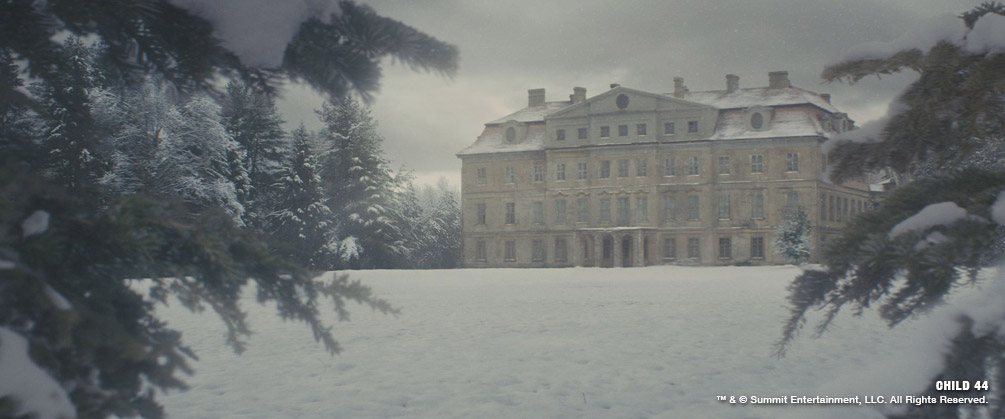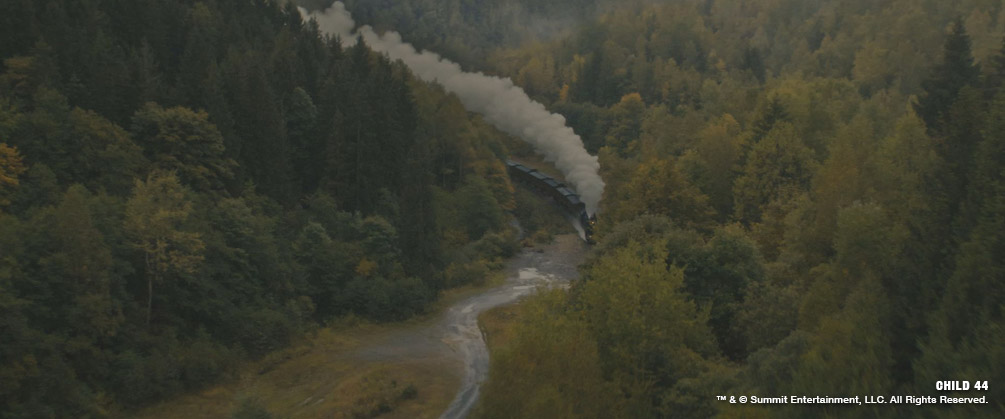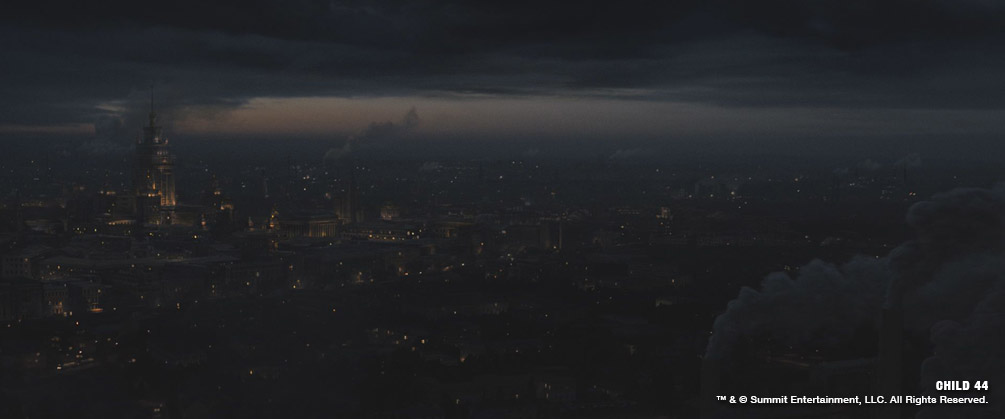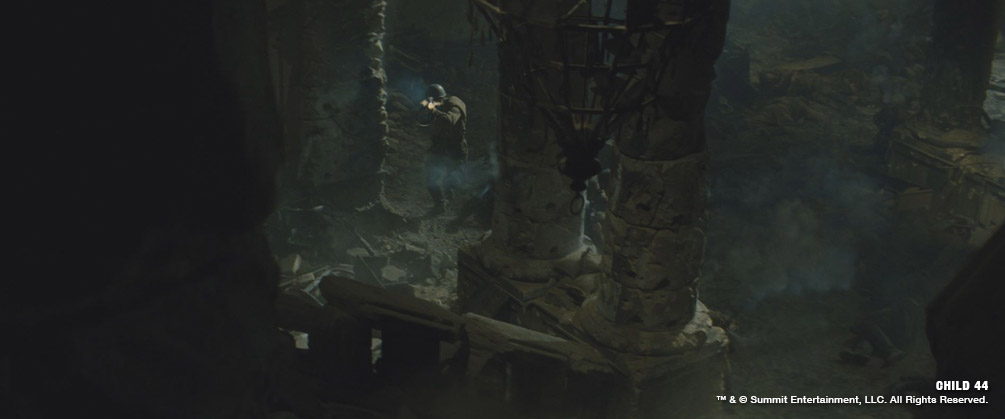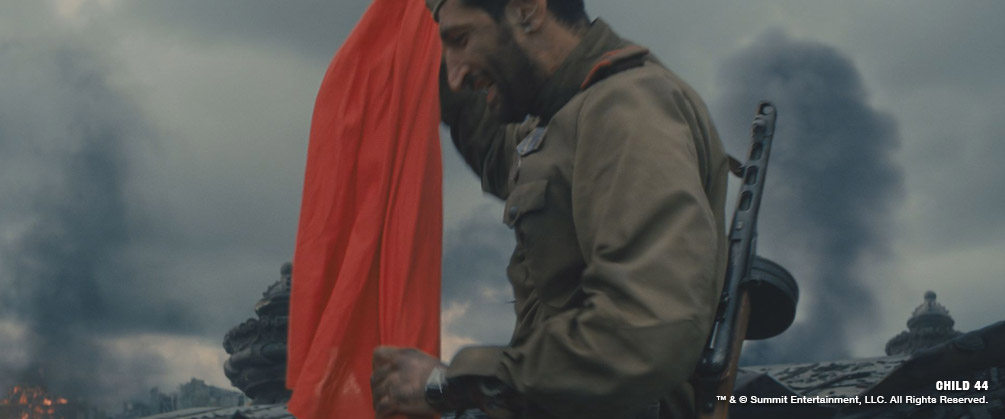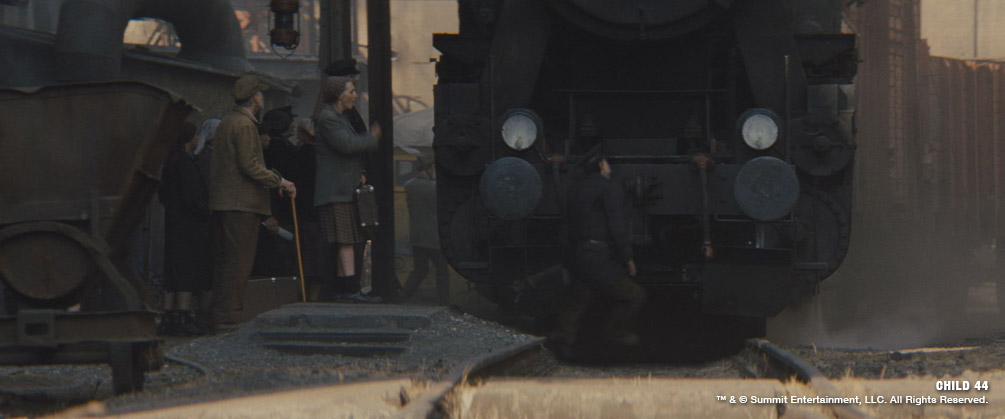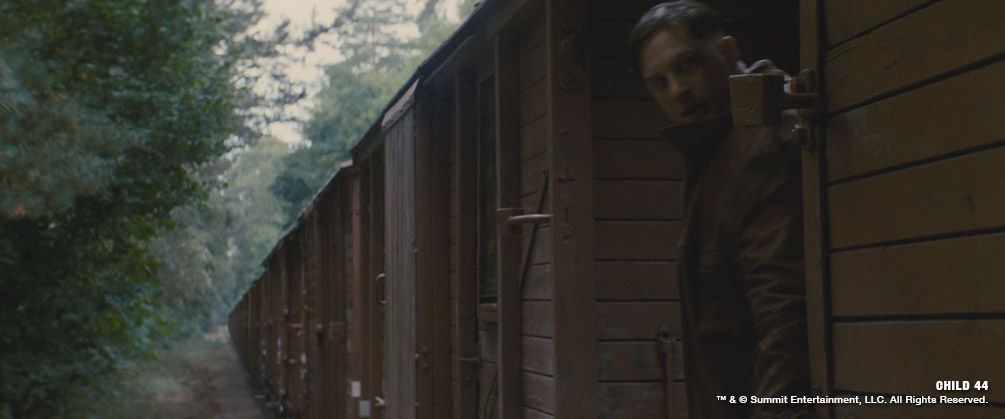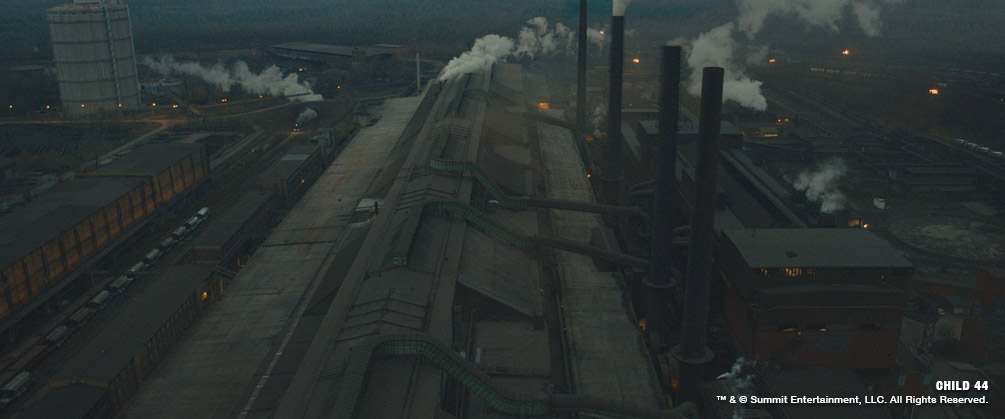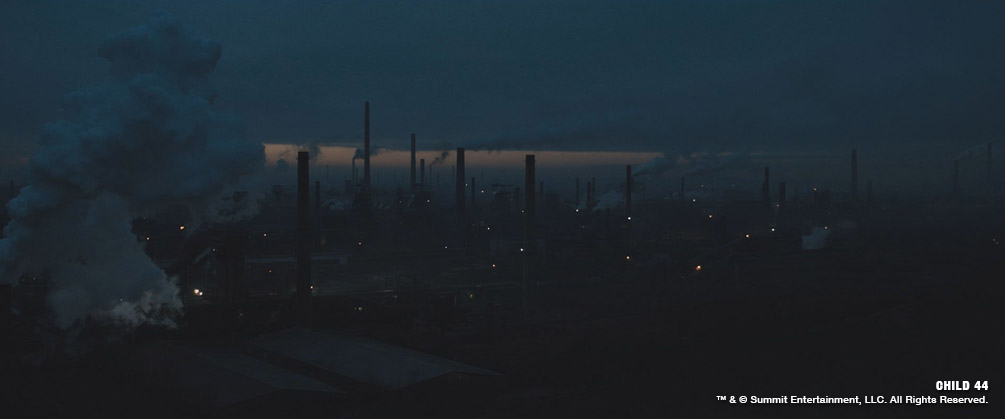Child 44 Case Study
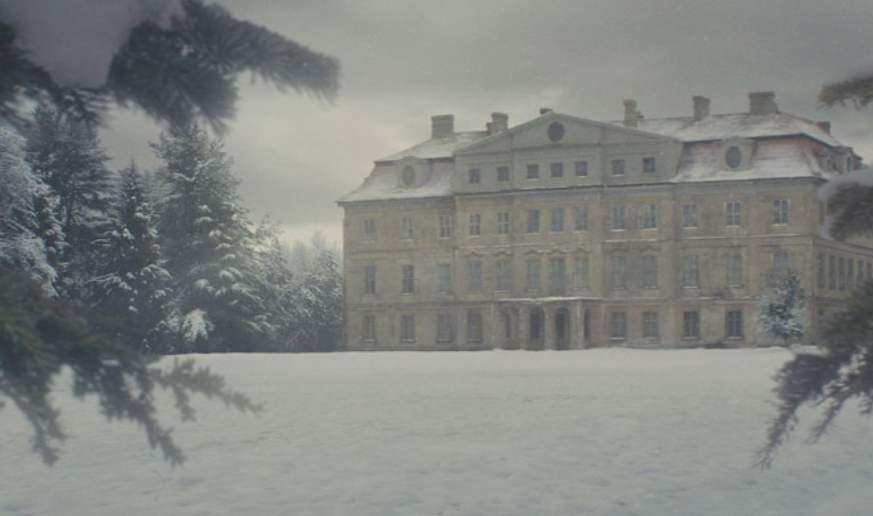
Case Study
As the sole vendor on Child 44, Image Engine both defined and delivered the 280 visual effects shots throughout the film. Read on to see how a strong level of trust between the team and director resulted in a high level of success.
Image Engine has created alien starships, sentient automatons, and undead creatures that morph and alter form, but for Child 44 the team took on a very different challenge – creating an authentic, and yet still somewhat mystical, version of early 1950’s Russia. What’s more, this was a task it had to face alone.
“Child 44 is an independent movie, which we worked on with director Daniel Espinosa as a result of previous work with Universal,” explains Edmond Engelbrecht, CG Supervisor on the project. “Daniel wanted just one vendor to handle the visual effects, as it was a smaller project. That sole vendor ended up being Image Engine.”
Taking place from the end of World War II and leading up to the death of Stalin in 1953, Child 44 tells the dark and uncompromising story of MGB Agent Leo Demidov (Tom Hardy) as he seeks to uncover a series of brutal and disturbing murders.
Although set in Stalinist Russia, the film was shot entirely in Prague, where Image Engine Visual Effects Supervisor Bernhard Kimbacher stayed for the five month shoot.
Image Engine worked on 280 shots in total, including extending a practical period train from three-five cars to 20-30; several environments, ranging from enhancing aerial shots of Prague to look like 1950’s Moscow to full CG industrial towns; and heavy 2D enhancements of battle scenes with smoke, bullet hits, muzzle flashes and gore elements. “There were a lot of interesting elements to the post-production,” says Kimbacher of the project. “There was a lot of seamless work, but even though it’s invisible VFX, much of it was nevertheless quite stylistic from a design perspective.”
“The film was made to feel uncomfortable and oppressed, with a lot of tight shots and framing designed to affect the audience’s mood and response,” he continues. “But Daniel also wanted larger shots, with the camera drifting over the landscape, which he described as ‘Blade Runner moments’. These shots, with the big vistas and the camera drifting over them, became crucial in contextualising Child 44’s dark narrative within the larger environment.”
Reimagining Moscow
Espinosa intended to weave an elaborate and expansive narrative through Child 44, but initially felt concerned that he would not be able to pull off the larger shots that would sell the postwar setting. That’s where Image Engine stepped in.
“Daniel is not a director who’s very used to visual effects, so making him trust us, helping him be more comfortable with the fact that we were going to make his shots the way he wanted them to be, was vital,” says Kimbacher.
“A big part of this was making Daniel comfortable with those wider angles; I don’t think he thought he had the budget to tackle that kind of shot,” continues Kimbacher. “It was up to us to convince him that he could deliver the shots on the budget we had. I think when we showed him the options he got really excited, and put more and more of that kind of larger, more expansive content back into the movie.”
In creating these wideangle panoramas of a WWII-ravaged Russia, Image Engine didn’t just need to transport the landscape back in time. It needed to alter the very setting, given that the plates were filmed on location in Prague. A challenge indeed, but one that can always be overcome with the knowledge gained from past experience.
“We have a large building library that we have created over time at the studio, and we took lots of photos of appropriate buildings, so the computer could build the architecture automatically, to a degree, using these reference points,” explains Engelbrecht. “Then we just sat down and laid it all out, pasting over the top of the comparatively simple city of Prague with a much more complex collection of buildings.”
Espinosa didn’t just want an exact, authentic replica of Moscow circa 1950, however, but needed the Image Engine team to add to it in such a way that would inform the themes and atmosphere of the film. “The city we created wasn’t realistic; it was quite stylistic – very atmospheric and moody. That made for a different kind of challenge,” says Kimbacher. “On past projects, such as Lone Survivor or Zero Dark Thirty, everything had to feel very real, whereas with Child 44 it was real, but also very stylised. We didn’t want to just emulate the period directly.”
This is where Espinosa’s concept of ‘Blade Runner moments’ came into play – sweeping industrial landscapes that didn’t just establish Child 44’s setting, but also the forbidding ambience of the narrative. “Daniel always said he didn’t want these shots to look too specific,” remembers Kimbacher. “He didn’t want to see any building in Moscow that he would recognise, and stated that we should make something that conveys the mood, rather than the reality, of Moscow. It was that mood, that atmosphere, that we aimed for, rather than the accuracy of the city’s layout.”
This atmosphere was alters slightly in the environment shots that take place before and after the death of Stalin in the film – the “old” and “new” Moscow, so to speak. “Most environment shots we did were in the old, oppressive Moscow, but then, after Stalin’s death, you do see a bit of brightness creep into the new, more open Moscow,” says Kimbacher. “We didn’t do too many shots in the new Moscow, but it’s still definitely a theme in the movie.”
The Battle of Berlin
Child 44 opens with the storming of the Reichstag – a famous and integral moment in the Battle of Berlin in 1945. The explosive scene had to open the movie with a bang, and although the special effects team performed a great job on set, it was up to Image Engine to really bring the scene to life.
“The storming of the Reichstag looked great to begin with, but they wanted more chaos – something they couldn’t get on set safely with practical special effects. It was up to us to really bring that in,” says Kimbacher. “I think that was the first time that Daniel handed us a whole sequence, and he was really surprised with what we did. When we sent it back to him he was amazed – he didn’t quite think that was how good we could make it look.
“We added elements from the large to small – things like squibs and muzzle flashes. It gave the scene a really big impact that definitely helped with the story.”
Following this action-packed set piece the characters make their way to the rooftop of the Reichstag. The original plan was to show an expansive wide shot of a battle-scarred Berlin, stretching out to the horizon. However, the limited budget was not able to meet these expenses. To overcome this issue, much of the perspective in these shots was pointed towards the sky, avoiding showing too much of the surrounding environment. Image Engine made sure the scene retained its drama with the addition of planes, smoke and other effects.
“We made extra effort with the planes going overhead,” says Engelbrecht. “Rather than just sticking them in the sky, we did research into actual squadron formations. That helped. We took extra care to make sure everything looked like it really would have looked, and just hinted at the destruction.”
Although these budgetary constraints kept the production scene from showing the full effect of the Battle of Berlin, for Kimbacher, the overall result was a positive one. “The budget restraints necessitated this approach, but it yielded a more personal story. The moment was told at a more human level – you’re really there with the characters, rather than just seeing a vista. And the vista isn’t the important part – the soldiers are. So the movie actually works better than if we’d gone with the big shot of Berlin. Sometimes having budget constraints isn’t necessarily a bad thing.”
A Versatile Approach
Image Engine employed its tried and trusted pipeline for Child 44 – an out-of-the-box solution that worked just fine for the demands of the production. The squadrons of planes cutting through the smoky skies of Berlin, for example, was created in Autodesk’s Maya. The team used the layout system and a custom layer approach that was designed to allow the team to complete tasks in the most simple and straightforward way possible.
“We set things up in such a way so that we don’t have to carry out tasks via a laborious process that demands lots of steps, which can often happen in other high-end work,” says Kimbacher. “With our pipeline, we can do visual effects-intensive movies like Chappie or Teenage Mutant Ninja Turtles, and then scale down to something like Child 44, without having to modify it too much, which is a good situation to be in.
“Generally the toolset has various people doing specific things, but with the CG department in Child 44 we had fewer people doing multiple tasks,” he continues. “That pushed them outside their comfort zones – it’s a great learning experience, and it’s fun!”
Building Trust
The shoot for Child 44 commenced in May 2014, with Kimbacher returning from the set in October. “It was a fairly long shoot – a bit of a slow-burner,” he remembers. “The script is very complex and it was hard to cut down into something that really did it justice – the original cut was about six hours! I think we underestimated how complex the script is and how much material we ended up with.”
However, a careful pre-production process ensured that all visual effects shots were laid out before filming began, meaning that none of Image Engine’s work had to be cut from the final product. “It was a long, but really smooth shoot,” says Kimbacher. “The one thing that was a bit difficult was the Moscow shot – Daniel had a specific idea of what he wanted from that – a clear picture in his head – so there was a bit more iteration on it. But he was very happy with the outcome.”
The strong relationship between Daniel Espinosa and Image Engine was key to this successful outcome, especially so given that Image Engine was the sole vendor responsible for the work. “That relationship was a huge factor,” says Shawn Walsh, Visual Effects Executive Producer. “With Child 44 we had such a big influence on how the movie looked. Usually when you’re working with other vendors you don’t have much input on the final product, so it’s good to be in a position where you’re getting the word straight from the horse’s mouth. Daniel was great with moving the pieces around in terms of budget, and working with someone who’s so open to your suggestions makes things so much easier. Going through the whole movie, saying, ‘We can fit this into this budget, this looks like it’s falling out, is any of that a concern?’ and him coming back with what he wants and needs – or doesn’t: it’s a big part of the dialogue. Working out what he’s willing to live without is a big part of it, and it boils down to what’s most important for the movie.”
“Daniel trusted us to figure it all out,” concludes Kimbacher. “We had a lot of leeway to do what we wanted and then show it to him. The level of trust was fantastic. If we weren’t the sole vendor we wouldn’t be on the shoot and the director probably wouldn’t even know our faces. But in this instance Image Engine was front and centre, helping to both define and deliver the invisible, and yet integral, visual effects.”



